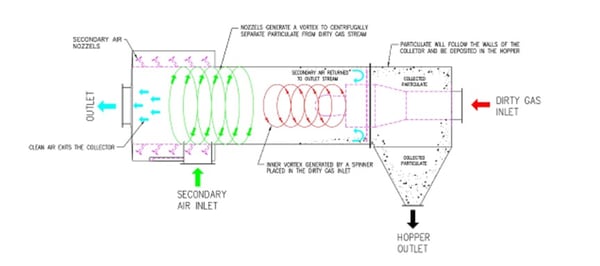One challenge to designing a manufacturing process is choosing an effective dust collection system that will fit the limited available plant space. Low ceilings pose a challenge for high-efficiency cyclones due to their long-tapered bodies. In many cases, the dust collector must be placed outdoors or partially protruding through the roof. This can be an unfavorable arrangement.
Counter-cyclonic dust collectors, such as the Aerodyne SplitStream™ Dust Collector, use a secondary air stream that directs material toward the collection hopper, and may be installed horizontally with virtually no loss of efficiency.
As the dust-laden gas stream is drawn into the collector, it passes through a stationary spinner which imparts a rotational flow and forces particulate toward the walls of the collector. A powerful secondary air stream is injected into a manifold where it enters the separation chamber through a series of nozzles. The secondary air stream intercepts the collected particulate and carries it to the hopper. Because this design does not rely on gravity to bring the dust to the hopper like conventional cyclones, its operational efficiency is not affected by horizontal installation.
This type of dust collector may be suspended from a ceiling, conserving valuable space on the manufacturing floor. It also saves money compared to cutting a hole through the roof or building a site for the dust collector outdoors. Outdoor installation may also encourage condensation that can shorten service life and reduce efficiency. Finally, horizontal, high-efficiency cyclones may be maintained without the need for tall scaffolding that can pose a safety hazard to workers.
To improve efficiency and safety, there is no substitute for an on-site inspection by an experienced expert. Click below to start with a free 20-minute phone consultation by clicking the button.

